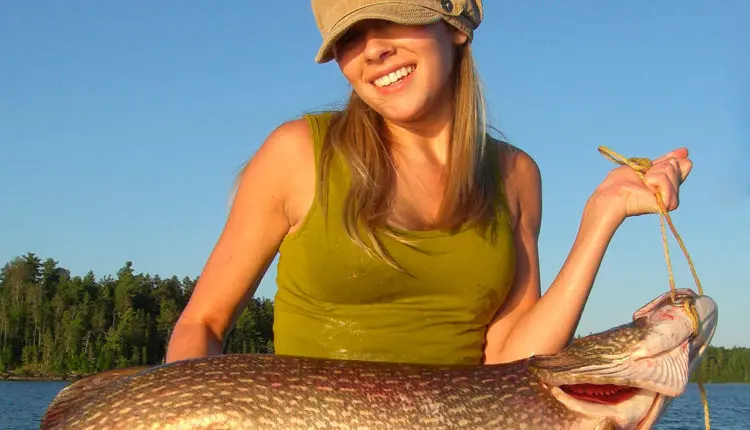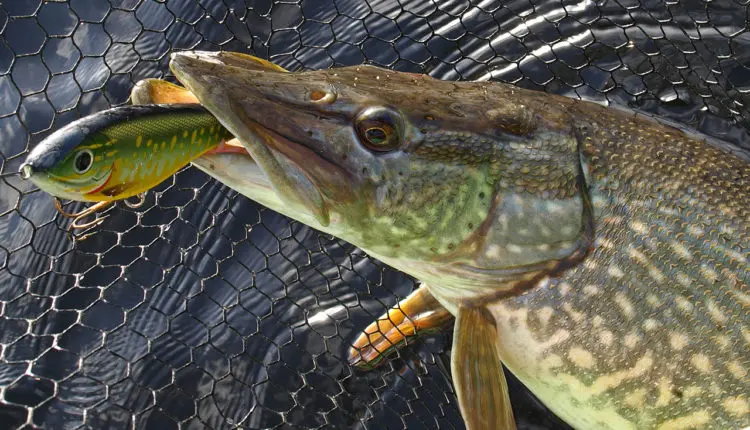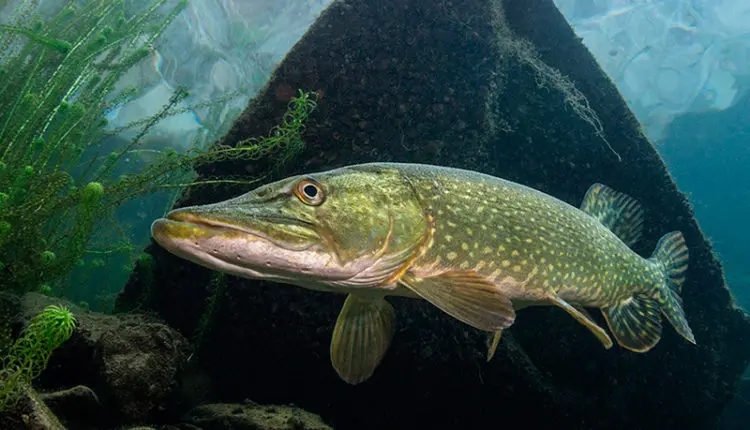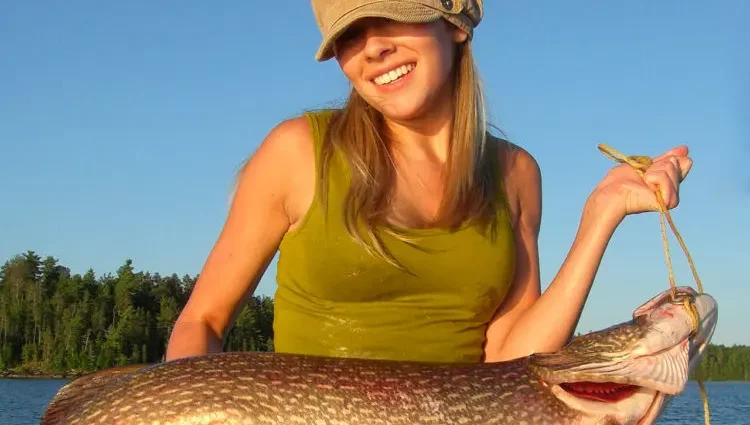Contents
They say that pike becomes passive in the heat. But this is not an axiom at all. In the very sun, most anglers leave the water area of the reservoir. Then it’s time to go fishing with spinning from a boat.
If in the cold autumn the pike stands on deep edges, then in the summer in the heat it is distributed over vast areas with little or no pronounced relief.
Where to look for pike on a pond in summer
In summer, in hot weather, pike moves to vast areas, the depth of which is less than the depth of the thermocline. During the day it is worth exploring irrigation, extended shallows among the depths, and shallow mounds.
There is a very dull watering, say, with a depth of 2–3 m without snags. Sailing it on a boat with an echo sounder, you look for at least some clue at the bottom, for example, an inconspicuous hollow, a weakly expressed edge, and then you make casts there in one place or another – and silence. But suddenly a bite occurs, and then this sometimes begins … The grips of pikes follow one after another.

On the reservoirs, there are barely noticeable ridges with a ledge height of only some 20–30 cm, which in many respects repeat the coastline and lie at the same depth. Sometimes they stretch almost in a straight line, sometimes with slight bends. On an unfamiliar reservoir, one has to painstakingly explore the bottom in search of such a feature. Such microbreaks are the result of the work of the surf (wind) current, which knocks them out on the ground in shallow areas of the reservoir, for example, in silty irrigation. Therefore, when searching for such features of the relief, one should first of all focus on the coast, towards which the winds predominantly blow.
The clear border of the grass at the bottom also indicates the real parking of the pike. The fact is that during the period of water discharge along the new coastline, algae managed to grow. Then the water level rose, the algae began to rot at a depth, but the food for the “white” fish remained in them. She comes here to feed, and then the pike pulls up. The spotted predator in such places feels at ease, completely merging with the vegetation. She can stand above the grass or in its midst, remaining invisible to the victim.
Pike and thermocline due to heat
During the formation of the thermocline, almost all fish stay above the level of occurrence of colder, but oxygen-poor water. Typically, the thermocline in reservoirs is formed at a depth of 2,5–3,5 m, rarely deeper. In open water expanses up to the depth of the thermocline, the water is well mixed under the influence of the daytime wind, saturated with oxygen, and small fish begin to actively move in search of food, followed by pikes. When the morning coolness gives way to heat, strong winds begin to blow and waves appear on the pond, it’s time to go hunting for a predator.

But we must bear in mind that where there is no wind, the pike will not hold; if you see one bite, then wait in this place for another.
Sometimes there are large concentrations of pike even in completely open places. There is a feeling that the “toothy” collectively surround a flock of little things, since they have no places for an ambush on even watering.
In my opinion, such clusters are formed in the following way. Some predator discovers a flock of fodder fish and begins to hunt. The pikes standing at a distance, hearing the sound of the capture of fish by the jaws of their relatives and orienting themselves in the direction of the wave and sound signals emanating from the panicking forage fish, one after the other are sent to a common feast. Thanks to highly developed sense organs: smell, hearing and lateral line in pikes, this happens quite quickly. Spotted predators always choose a method of hunting that will optimally saturate them.
It should be remembered that in warm water the predator is more often full than hungry. She has enough food, and she absorbs a lot of it. But the metabolic rate is higher in warm water, and ingested fish is quickly digested. although it happens that a pike’s stomach is completely full of fish, but after 15-20 minutes after the next attack, it is ready to receive a new portion of food. However, in the heat, the pike bites very carefully and constantly. These are the main features of her behavior in the summer months.
In cold autumn water, pike use much more energy to forage. She constantly feels hungry and takes greedily. But in chilled water, food is digested for a long time, fatty deposits are formed slowly, and it is often necessary to observe a picture when a tail of a fish that has not yet been swallowed sticks out of the throat of a freshly caught pike.
How to catch pike in low water
There are years when there is little water in the reservoirs and the situation changes. There are no flooded surf edges, no stumps and snags – all this remained on land after the water had subsided. Where previously the depth was 6 m, now it has become 2 m. And yet you should not become attached to the mouths of streams and rivers. The pike still feeds on irrigation, even the most open ones, despite the fact that there are no shelters for it now. And in the catches come across, as always in the heat, the largest individuals. Pike weighing 2-3 kg is a common thing. Often the specimens are pulled by 6–8 kg, and some of my friends were lucky to catch a bigger pike.

Biting in windy hot weather usually occurs from about 11 am to 15 pm. The stronger the wind, the better the bite. Only “laces” of 300–500 g peck in the calm. The best condition for catching pike is a sultry midday strong wind. Then you definitely need to get up into the wind, otherwise it is difficult to cast a light jig bait. And so that the boat does not blow away, you need to lower the anchor on a long rope, usually at least 20 m.
During the period of low water, there are areas where the pike stands tightly, but the bait at the bottom cannot be carried out. Once, at the Rybinsk Reservoir, my friend and I found a cluster of logs in the watering with a depth of 1 m, in which there was a pike, and it was impossible to offer it ordinary baits, and even in fairly clear water. It’s good that a friend found jig heads weighing 4 g with large hooks. Picking up twisters of different colors and quality and carrying out wiring almost on top, we finally achieved that bites began to follow almost on every cast. The result is a dozen pikes from one point.
From the experience of that fishing, I concluded that when fishing aground in bright sunlight and in clear water, dark-colored twisters and vibrotails (preferably black or brown) should be used, which the pike perceives as contrasting against the sun, like the silhouettes of fish. During that fishing, we noticed that shoals of various small fish were scurrying over the logs.
Hemp, mounds and other pike shelters
When the water level drops in summer, shallow waters are often exposed, densely dotted with stumps from the once reduced forest. There are a lot of such sites on the Yauzsky, Mozhaysky, Ruzsky and other reservoirs. If the wind blows over such an area, enriching the water with oxygen, then a pike is always in ambush near the stumps. For successful fishing, it is only important to choose the right bait and make accurate casts to the place where the predator is supposed to hide.

When fishing near stumps, where the depth is only 1 m, you can successfully use both specially selected jig lures and spinners with a wide petal. For pike, the slower the line, the better. Well, when the heavy core is removed from the spinner, then when it falls into the water, it plans attractively for a moment. This sometimes causes a bite before the start of the wiring, until the petal “turns on”. As for the “rubber”, by choosing the right ratio of the mass of the load-head and the size of the blade of the vibrotail (twister), you can make the bait fall at the desired speed. Often, as soon as she touches the water, a bite should follow. Or you do two or three rotations with the reel handle and you feel a pike blow.
Another category of vast areas is irrigation, on which there should be hemp and snags, but they still need to be looked for. And at the only such shelter on a large area of uXNUMXbuXNUMXbthe “empty” bottom, sometimes up to a dozen or more predators can stand. Sometimes you don’t even find a stump or a snag on an unremarkable watering, but just some kind of grass bush, and around it there are a lot of predators. Then pike bites follow one after another, and you save this bump like a jewel: God forbid you hook it with a hook and destroy it.
Another feature is underwater mounds. In many reservoirs, there are hillocks located at a depth of 2–3 m, that is, also above the thermocline boundary. It is desirable that there are significant differences in depths around. Usually, clusters of perch can be found on the hillocks. But, for example, on the Mozhaisk reservoir in such local points there are more pike than perch. Sometimes, in the area of the hillocks, instead of pike, the spinner comes across pike perch. When I watched the powerful bursts of this predator on the Mozhaisk reservoir, I sometimes heard the fishermen claim that it beats the asp. But there is no asp on Mozhaika for a long time. And pike perch in the heat often actively walks at half water and feeds in places where forage fish accumulate. True, the “fanged” is more difficult to calculate than the pike. In hot weather, it can hunt both in the area of hillocks and throughout the entire water area above its favorite depths of 10–14 m, feeding on bleak and roach that have risen above the thermocline. But at the same time, try to find pike perch if it does not reveal itself to be fighting on the surface … Mounds, on the other hand, serve as a good guide for catching any predator.
In order to successfully fish on hillocks, after tapping the bottom with a jig bait and finding out the underwater terrain, you need to switch to casting with a wobbler with a depth of 1,5 m. Standing on a drifting or moored boat, fan casts should be made in all directions. It is important not to stand still, but to move around the water area, adhering to the discovered underwater hill. Pike on hillocks is well caught on wobblers with a depth of 2–3 m, depending on the depth of the top of the hillock. Pike among sparse plants in shallow water loves short pot-bellied baits such as cranks, and willingly takes different sheds along the edges of mounds. But when catching a predator with any bait, except jig, you have to move too much due to relatively short casts. In addition, in summer the water is usually cloudy or greenish due to flowering, so pike, when hunting, relies more not on sight, but on the waves emanating from the fish.
A well-known rule says: what is the activity of the pike, such should be the parameters of the oscillatory movements of the “rubber”. If the pike is active, an intensively playing vibrotail is used, if it is sluggish, then the bait should be “quiet”. By cutting the blade of a vibrotail or twister in a certain way, their vibrations can be made high-frequency or low-frequency. So you can ensure that this or that bait still likes the pike, and then it attacks it. However, not every spinning player is ready to go for such experiments, preferring to simply put another ready-made bait.
For fishing in the heat, I like an ordinary “foam rubber”. Due to the positive buoyancy of the material, the “foam rubber” is held at a large angle with respect to the bottom surface when retrieving. Probably, it is for this reason that pike notices foam rubber fish from afar on shallow waterings. I use homemade “carrots” cut with scissors from a suitable foam rubber. The advantage of this type of bait is that you can put a slightly heavier sinker on them (since it does not affect the “foam rubber” game) and use a longer cast. This is sometimes useful in shallow areas where the pike avoids the drifting boat. This is also good when wiring with wire, when the sinker is dragged along the bottom, leaving a path of turbidity, which also attracts pike.
In conclusion, it is worth mentioning once again the importance of an echo sounder, which is quite difficult to do without when searching for pike in reservoirs. However, if the angler has studied the reservoir well, then it is possible to fish on irrigation using known and permanent landmarks on the shore: power lines and masts, buildings and tall structures. Another way to detect pike is simple: you fasten a wobbler with a depth of 1–1,5 m and guide it through watering on oars in the old-fashioned way – the “path”. After the first bite and, possibly, catching a pike, you throw a buoy overboard, anchor and catch a point with a series of fan casts. As a rule, in the place where one pike caught, you can hardly wait for the next bite of another predator. But literally 3–5 m from the point of catching the first pike, you can catch a few more, because in the heat the predators are grouped around the most comfortable place for parking.










